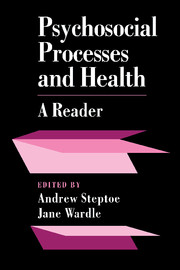Book contents
- Frontmatter
- Contents
- Preface
- Section 1 Life stress, social support and health
- Section 2 Psychophysiological processes in disease
- Section 3 Personality, behaviour patterns and health
- Section 4 Health practices and the modification of health risk behaviour
- A multivariate analysis of health-related practices: a nine-year mortality follow-up of the Alameda County Study
- The Health Belief Model and participation in programmes for the early detection of breast cancer: a comparative analysis
- Health promotion and the compression of morbidity 308
- Community education for cardiovascular health
- Primary prevention of cancer among children: changes in cigarette smoking and diet after six years of intervention
- Section 5 Coping with illness and disability
- Section 6 Behavioural interventions in medicine
- Index
Community education for cardiovascular health
from Section 4 - Health practices and the modification of health risk behaviour
Published online by Cambridge University Press: 05 August 2016
- Frontmatter
- Contents
- Preface
- Section 1 Life stress, social support and health
- Section 2 Psychophysiological processes in disease
- Section 3 Personality, behaviour patterns and health
- Section 4 Health practices and the modification of health risk behaviour
- A multivariate analysis of health-related practices: a nine-year mortality follow-up of the Alameda County Study
- The Health Belief Model and participation in programmes for the early detection of breast cancer: a comparative analysis
- Health promotion and the compression of morbidity 308
- Community education for cardiovascular health
- Primary prevention of cancer among children: changes in cigarette smoking and diet after six years of intervention
- Section 5 Coping with illness and disability
- Section 6 Behavioural interventions in medicine
- Index
Summary
Summary
To determine whether community health education can reduce the risk of cardiovascular disease, a field experiment was conducted in three northern California towns. In two of these communities there were extensive mass-media campaigns over a 2-year period, and in one of these, face-to-face counselling was also provided for a small subset of high-risk people. The third community served as a control. People from each community were interviewed and examined before the campaigns began and one and two years afterwards to assess knowledge and behaviour related to cardiovascular disease (e.g., diet and smoking) and also to measure physiological indicators of risk (e.g., blood-pressure, relative weight, and plasma-cholesterol). In the control community the risk of cardiovascular disease increased over the two years but in the treatment communities there was a substantial and sustained decrease in risk. In the community in which there was some face-to-face counselling the initial improvement was greater and health education was more successful in reducing cigarette smoking, but at the end of the second year the decrease in risk was similar in both treatment communities. These results strongly suggest that mass-media educational campaigns directed at entire communities may be very effective in reducing the risk of cardiovascular disease.
Introduction
Cigarette smoking, high plasma-cholesterol concentrations, and high blood-pressure are important risk factors for premature cardiovascular disease. In 1972 we began a field experiment in three northern California communities to attempt to modify these risk factors by community education.
The mass media, face-to-face instruction, or combinations of the two may be used in community education campaigns. The habits influencing cardiovascular risk factors are complex and longstanding ones, are often reinforced by culture, custom, and continual commercial advertising, and are unlikely to be strongly influenced by mass media alone. Face-to face instruction and exhortation also have a long history of failure, particularly when aimed at producing permanent changes in diet and smoking habits. The disappointing results of a very limited attempt to reduce cardiovascular risk with a direct mail and lecture campaign reinforced pessimism about the possibility of changing health behaviour through public education.
After considering the powerful cultural forces which reinforce and maintain the health habits that we wished to change, and in view of the failure of past health education campaigns, we decided to use an untested combination of an extensive mass-media campaign plus a considerable amount of face-to-face instruction.
- Type
- Chapter
- Information
- Psychosocial Processes and HealthA Reader, pp. 316 - 324Publisher: Cambridge University PressPrint publication year: 1994
- 2
- Cited by



